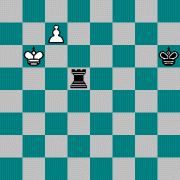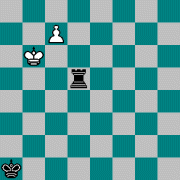THE DISCOVERY OF THE SAAVEDRA
In a legendary article in the Dutch national chess magazine for November 1940, the endgame composer and writer John Selman unearthed how the famous Saavedra position came into being, in 1895, in the chess column of a Glasgow paper, the 'Weekly Citizen'.
When the well known London player Potter died in March of that year, chess editor G.E. Barbier wrote an obituary. A few weeks later, on 27 April, he published a position from one of Potter's games - remembering it wrongly, as Selman demonstrated. But precisely that was the first step to the masterpiece.
Below, I will reproduce (for the first time as far as I know), exactly what then happened on 5 consecutive Saturdays in Barbier's chess column in the Weekly Citizen. It was a sizable column, and what you will find here are small sections of it. I've tried to make them look like the original as much as possible. I have copied the mistakes; on May 4 'the diagram above' should have read 'the diagram below', and on May 18, 'White' and 'Black' are mixed up, as Barbier himself explains a week later.
WEEKLY CITIZEN, SATURDAY, APRIL 27, 1895.
Mr. Potter.
Black - Potter.
White - Fenton.
Black to play and White to win.
The above ending occurred in a game played between Messrs. Potter and Fenton some years ago. In this position, the board was crowded round with spectators, and one might have overheard the words: "Draw, draw," exchanged among them. Mr. Potter asked Mr. Fenton if he would take a draw, and the latter replied in the affirmative, as he had come to the conclusion that the Pawn must be exchanged for the Rook. For example, if Black checks at Queens's third, and if White King goes to Bishop's 5, then Rook goes to Queen's 8 and the Pawn falls for the Rook; if White King moved to Knight 7, then Rook would go to Queen's second, drawing at once. After Mr. Fenton had accepted a draw, Mr. Potter asked leave to show him the way in which he could have won. We will give the solution next week.
WEEKLY CITIZEN, SATURDAY, MAY 4, 1895.Solution of Mr. Potter's End Game.
Black checks at Queen's third, White King moves to Knight's fifth, being the only move to win, as if it moves to Bishop fifth, attacking the Rook, Black plays Rook to Queen's eight, occupying Queen's Bishop's eighth next move, thus drawing.
Now Black's only chance is in keeping up his checks, at Queen's fourth, fifth, and sixth, and the White King will move homeward on the same Knight's file, avoiding the Bishop's file, till it is checked at Black's Queen's sixth, when it moves to Bishop's second, and as there are limits to the board, the Black Rook is no longer able to attack White's rear, and resigns. From this position we have formed the one on the diagram above, which exemplifies an interesting manner of drawing a game in similar positions.
________________________________
End Game (414).
Black.
White.
Black moves and draws.
Based on actual play between Messrs. Potter
and Fenton.
WEEKLY CITIZEN, SATURDAY, MAY 11, 1895.Solution of End Game No. 414
Black checks at Queen's 3, 4, 5, and 6, according to White's play, who, to delay the draw, should move his King on the knight's file, reaching his Queen's Bishop's 2, attacking the Rook. Now the position is the same as that in Mr. Potter's end game, with the exception of the Black King, which, by its proximity to the White King, is enable to secure a stalemate. The White King now is at Bishop's 7. The attacked Black Rook moves to Queen's 5, and, on White queening, checks at Bishop's 5, this leaving Black no square to move on.
WEEKLY CITIZEN, SATURDAY, MAY 18, 1895.End Game (No.416)
Black.
White.
Black moves and White wins.
This endgame is numbered 416, but it might just as well be numbered 414, since it is absolutely the same position which apeared in our issue of May 4. The conditions attached to that position, however, were: Black moves and draws, but to-day they are: Black moves and White wins. In our last issue we gave the solution of what we thought was a draw, brought about by a stale-mate as follows:-
White. Black.
1. R to Q3 (ch.) K to Kt5
2. R to Q4 (ch.) K to Kt4
3. R to Q5 (ch.) K to Kt3
4. R to Q6 (ch.) K to B2
5. R to Q5! P Queens
6. R checks Queen takes
7. Stale-mate
But a member of the Glasgow Club, the Reverend Saavedra, has pointed out a win for White. The position is a very remarkable one.
WEEKLY CITIZEN, SATURDAY, MAY 25, 1895.
Solution of End Game No. 416
In the solution given last week of this position, it is Black which should begin the checks, and not White.
Black. White.
1. R to Q3 (ch.) K to Kt5
2. R to Q4 (ch.) K to Kt4
3. R to Q5 (ch.) K to Kt3
4. R to Q6 (ch.) K to B2
5. R to Q5!
Now Black is awaiting the White Pawn going to Queen, in order to obtain a stale-mate, as pointed out in our last issue, by R to B5 (ch.). But White does not get a Queen. He gets a Rook! threatening R to R8 (ch.) and mate next move. Note the secluded and uncomfortable position of the Black King. Black does not like to be mated so soon; so he moves 6.R to R5. White now plays 6. King to Knight's 3, and mate follows or Black's Rook is lost.
This position is one of the most remarkable end games we have seen for many years.
Top of page | Main chess page | Main page